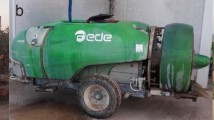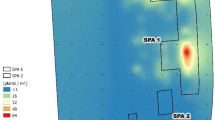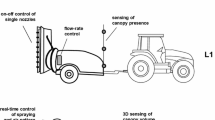Abstract
Specialty crops, such as apples, are vulnerable to insects and pathogens, and require higher pesticide input than row crops, a significant fraction of which is off-target loss, causing adverse environmental and socio-economic impacts. An advanced laser-guided variable-rate sprayer (VRS) could improve spray deposition uniformity and minimize pesticide waste, while maintaining efficacy against insects and pathogens. Despite these merits, retrofitting a conventional sprayer with laser-guided variable-rate spraying functions adds to its cost. Thus, the objective of this study was to analyze the techno-economics of a conventional pesticide sprayer retrofitted with VRS, in comparison to a conventional constant-rate sprayer (CRS) for pesticide application during apple production. A techno-economic model was developed for the apple orchards covering areas of 4 and 20 ha, which are common orchard sizes in the USA. The model incorporated cost for operation, equipment, fuel use and labor during pesticide application. The data were obtained from field tests in orchards in Ohio, USA in years 2016 and 2017, literature, and the original VRS development team at USDA-ARS and Ohio State University. The results indicated that VRS can reduce pesticide costs by 60–67%, pesticide application time by 27–32% and labor and fuel by 28% compared to CRS. For larger orchards, VRS also reduced equipment requirement. Compared to CRS, overall annual pesticide application cost savings by using VRS were between $1420 and $1750 ha−1. The payback time for using VRS was estimated to be between 1.1 and 3.8 years for apple orchards between 4 and 20 ha, respectively, in Ohio.








Similar content being viewed by others
References
AGCO. (2020). Massey Ferguson Tractors. Retrieved Feb 1, 2020, from https://www.masseyferguson.us/products/tractors/4700-series-utility-tractors.html.
AgDirect. (2020). Rates for purchasing new or used equipment at the dealership. Retrieved Feb 11, 2020, from https://www.agdirect.com/docs/default-source/rates/currentrates.pdf.
Agriculture Solutions. (2020). Skid sprayers. Retrieved Feb 1, 2020, from https://www.agriculturesolutions.com/gardening-equipment/agricultural-sprayers/skid-sprayers.
Bureau of Labor Statistics. (2018). Occupational employment and wages, 45-2091 agricultural equipment operators. Occupational employment statistics. Retrieved Feb 11, 2020, from https://www.bls.gov/oes/current/oes452091.htm.
Chen, Y., Ozkan, H. E., Zhu, H., Derksen, R. C., & Krause, C. R. (2013). Spray deposition inside tree canopies from a newly developed variable-rate air-assisted sprayer. Transactions of the ASABE, 56(6), 1263–1272.
Chen, Y., Zhu, H., & Ozkan, H. E. (2011). Development of LIDAR-guided sprayer to synchronize spray outputs with canopy structures. Paper No 1110496, St Joseph, MI, USA: ASABE.
Dammer, K.-H., Thöle, H., Volk, T., & Hau, B. (2009). Variable-rate fungicide spraying in real time by combining a plant cover sensor and a decision support system. Precision Agriculture, 10(5), 431–442. https://doi.org/10.1007/s11119-008-9088-7.
Fernandez-Cornejo, J., Jans, S., & Smith, M. (1998). Issues in the economics of pesticide use in agriculture: A review of the empirical evidence. Review of Agricultural Economics, 20(2), 462–488. Retrieved Feb 11, 2020, from www.jstor.org/stable/1350002.
Giles, D., Klassen, P., Niederholzer, F., & Downey, D. (2011). “Smart” sprayer technology provides environmental and economic benefits in California orchards. California Agriculture, 65(2), 85–89.
Jeon, H. Y., Zhu, H., Derksen, R. C., Ozkan, H. E., Krause, C. R., & Fox, R. D. (2011). Performance evaluation of a newly developed variable-rate sprayer for nursery liner applications. Transactions of the ASABE, 54(6), 1997–2007.
John Deere. (2018). 5090 EL specialty tractor. Retrieved Feb 11, 2020, from https://configure.deere.com/cbyo/#/en_us/products/agriculture/tractors/specialty_tractors.
Kistner, E., Kellner, O., Andresen, J., Todey, D., & Morton, L. W. (2018). Vulnerability of specialty crops to short-term climatic variability and adaptation strategies in the Midwestern USA. Climatic Change, 146(1), 145–158. https://doi.org/10.1007/s10584-017-2066-1.
Machinio. (2018). Jacto Arbus. Retrieved Feb 11, 2020, from www.machinio.com/cat/orchard-sprayer#quickview/28737807.
Midwest Tree Fruit Spray Guide. (2012). Retrieved Feb 11, 2020, from https://ag.purdue.edu/hla/fruitveg/Documents/pdf/2012ID168.pdf.
MM Sprayers USA. (2017). MM Airblast Trailer sprayer. Retrieved Feb 11, 2020, from www.mmsprayersusa.com/product/mm-bg-600-airblast-trailer-sprayer-pto/.
Parker, M., Unrath, C. R., Safley, C., & Lockwood, D. (1998). High density apple orchard management. Retrieved Feb 11, 2020, from https://content.ces.ncsu.edu/high-density-apple-orchard-management#.
Sedlar, A. D., Bugarin, R. M., Nuyttens, D., Turan, J. J., Zoranovic, M. S., Ponjican, O. O., et al. (2013). Quality and efficiency of apple orchard protection affected by sprayer type and application rate. Spanish Journal of Agricultural Research, 11(4), 935–944.
Shen, Y., Zhu, H., Liu, H., Chen, Y., & Ozkan, E. (2017). Development of a laser-guided, embedded-computer-controlled, air-assisted precision sprayer. Transactions of the ASABE, 60(6), 1827–1838.
Slattery, E., Livingston, M., Greene, C., & Klonsky, K. (2011). Characteristics of Conventional and Organic Apple Production in the United States. FTS-347-01, Economic Research Service, USDA.
Sprayer Depot. (2017). Durand Wayland air sprayer. Retrieved Feb 11, 2020, from https://www.sprayerdepot.com/collections/fmc-john-bean#/filter:product_type:FMC$2520Sprayers.
Sprayers101. (2017). Increase sprayer productivity without driving faster. Retrieved Feb 11, 2020, from https://sprayers101.com/increase-sprayer-productivity-without-driving-faster/.
Stover, E., Salvatore, J., & Wirth, F. (2003). Pesticide spray reduction from using a sensor-actuated spray system in Indian River Grapefruit. HortTechnology, 13(1), 178–181.
Suárez-Jacobo, A., Alcantar-Rosales, V. M., Alonso-Segura, D., Heras-Ramírez, M., Elizarragaz-De La Rosa, D., Lugo-Melchor, O., et al. (2017). Pesticide residues in orange fruit from citrus orchards in Nuevo Leon State, Mexico. Food Additives & Contaminants: Part B, Surveillance, 10(3), 192–199.
The National Agricultural Law Center. (2017). Specialty crops—An overview. Retrieved Apr 10, 2017, from https://nationalaglawcenter.org/overview/specialty-crops/.
Tractorhouse. (2018). Listings for case IH tractors. Retrieved Oct 10, 2018, from https://www.tractorhouse.com/listings/farm-equipment/for-sale/list/category/1110/tractors-40-hp-to-99-hp?NotFound=1&Manu=CASE+IH&Mdltxt=JX90&mdlx=Contains.
U.S. Apple Association. (2020). The apple industry. Retrieved Feb 1, 2020, from https://usapple.org/what-we.
U.S. Energy Information Administration. (2017). U.S. No 2 diesel ultra low sulfur (0–15 ppm) retail prices. Retrieved Nov 19, 2017, from www.eia.gov/dnav/pet/hist/LeafHandler.ashx?n=PET&s=EMD_EPD2DXL0_PTE_NUS_DPG&f=A.
University of Minnesota. (2018). Before you start an apple orchard. Fruit Research. Retrieved Feb 02, 2020, from https://fruit.umn.edu/content/before-start-apple-orchard.
USDA. (2012). 2012 Census of agriculture. Retrieved Feb 11, 2020, from www.agcensus.usda.gov/Publications/2012/Full_Report/Volume_1,_Chapter_1_US/st99_1_002_002.pdf.
Xu, X.-M., Murray, R. A., Salazar, J. D., & Hyder, K. (2008). The temporal pattern of captan residues on apple leaves and fruit under field conditions in relation to weather and canopy structure. Pest Management Science, 64(5), 565–578.
Zhu, H., Rosetta, R., Reding, M. E., Zondag, R. H., Ranger, C. M., Canas, L., et al. (2017). Validation of a laser-guided variable-rate sprayer for managing insects in ornamental nurseries. Transactions of the ASABE, 60(2), 337–345.
Acknowledgement
This work was supported by funding from United States Department of Agriculture NIFA Specialty Crops Research Initiative (Award no. 2015-51181-24253). The authors also gratefully acknowledge Fred Finney and Steve Finney, President and Farm Manager of Moreland Fruit farm, Wooster, OH for their cooperation in providing operating facilities, equipment, apple orchard, field operation, and documentation of chemical application costs.
Author information
Authors and Affiliations
Corresponding author
Additional information
Publisher's Note
Springer Nature remains neutral with regard to jurisdictional claims in published maps and institutional affiliations.
Rights and permissions
About this article
Cite this article
Manandhar, A., Zhu, H., Ozkan, E. et al. Techno-economic impacts of using a laser-guided variable-rate spraying system to retrofit conventional constant-rate sprayers. Precision Agric 21, 1156–1171 (2020). https://doi.org/10.1007/s11119-020-09712-8
Published:
Issue Date:
DOI: https://doi.org/10.1007/s11119-020-09712-8




